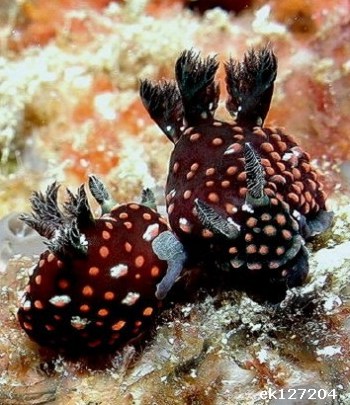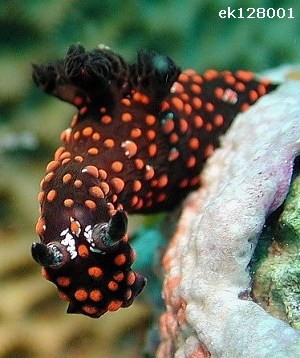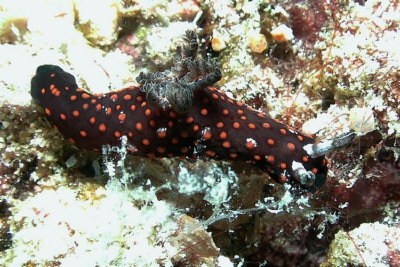

Nembrotha cf. guttata
Yonow, 1993
Order: NUDIBRANCHIA
Suborder: DORIDINA
Superfamily: ANADORIDOIDEA
Family: Polyceridae
Subfamily: Nembrothinae
PHOTO
Moalboal, Cebu Island, Philippines. UPPER: (ek127204) divesite "Dolphin House", depth 21 m, length 48 + 39 mm, June 01, 2001. LOWER: (ek128001) divesite "Umbrella", depth 29 m, length 53 mm, June 05, 2001. Photos: Erwin Koehler.
I had previously identified this animal as N. guttata but that animal has significant colour differences.
Compare with N. cristata, N. kubaryana, N. guttata and red-spotted species
Reference:
• Yonow, N. (1993) Opisthobranchs from the Maldive Islands, includng descriptions of seven new species (Mollusca, Gastropoda). Revue fr. Aquariol., 20: 97-130.
Rudman, W.B., 2002 (January 28) Nembrotha cf. guttata Yonow, 1993. [In] Sea Slug Forum. Australian Museum, Sydney. Available from http://www.seaslugforum.net/find/nembcfgutt
Related messages
Re: Nembrotha cf. guttata changing colors
February 14, 2007
From: Mike Krampf
Concerning message #19443:
Sorry Bill but I don't have any other pictures of the mating pair in my first message. I may have been too quick to delete some pictures that could have been valuable.
Thanks as always for your insights.
Mike
mtkrampf@yahoo.com
Krampf, M., 2007 (Feb 14) Re: Nembrotha cf. guttata changing colors. [Message in] Sea Slug Forum. Australian Museum, Sydney. Available from http://www.seaslugforum.net/find/19448Thanks Mike,
It's always worth asking.
Best wishes,
Bill Rudman
Re: Nembrotha cf. guttata changing colors
February 13, 2007
From: Mike Krampf

Concerning message #19244:
Here is one other related picture that was taken on the same dive in the same area. As you can see these are also in the process of changing colors but both still have the white specks that are common on the red-spotted form. Hope this helps.
Locality: Dive Site - Dunia Kecil off Wajil island, 45 ft, Raja Ampat, Indonesia, Banda Sea, 30 December 2006, Reef. Length: 3-4 cm. Photographer: Mike Krampf.
Cheers,
Mike
mtkrampf@yahoo.com
Krampf, M., 2007 (Feb 13) Re: Nembrotha cf. guttata changing colors. [Message in] Sea Slug Forum. Australian Museum, Sydney. Available from http://www.seaslugforum.net/find/19443
Thanks Mike,
This photo certainly shows the white patches very well. From the close-up showing the white patches inside the gill circlet, it seems that they are glands - perhaps storing anti-feedant chemicals?
Sorry to be choosey, but what I would really like is another photo of the green-spotted one in the mating pair in your first message to see if it has white patches as well. If it doesn't, it will suggest that the ones without white patches - which we identify as N. guttata, and the ones with white patches - which I have considered different, are probably all one species.
Best wishes,
Bill Rudman
Nembrotha cf. guttata changing colors in Raja Ampat
February 12, 2007
From: Mike Krampf


I thought you would find these pictures interesting. There were quite a few of these nudi's on the dive and it certainly appeared that they were in the process of changing colors from red-spotted to green-spotted. As you can see from the first photo there were a few that were completed red-spotted and there were a few, like in the upper photo, where it appeared that it was in the process of changing to green-spotted.
At the end of the dive I found the different colored ones mating.
Locality: Dive Site - Dunia Kecil off Wajil island, 45 ft, Raja Ampat, Indonesia, Banda Sea, 30 December 2006, Reef. Length: 3-4 cm. Photographer: Mike Krampf.
Thanks as always for your time and input.
Mike
mtkrampf@yahoo.com
Krampf, Mike, 2007 (Feb 12) Nembrotha cf. guttata changing colors in Raja Ampat. [Message in] Sea Slug Forum. Australian Museum, Sydney. Available from http://www.seaslugforum.net/find/19244
Dear Mike,
Thanks for these photos. It is interesting that 'typical' N. guttata has this changing colour of the tubercles from red to green as well. I have always thought that this species was different from N. guttata - the tubercles seem smaller and there are always patches of white on the inside edge of each rhinophore and along the mantle edge of many individuals. However in your photo alongside, of the two mating, the green spotted animal seems to lack the white markings, and so looks as though it is N. guttata. If this is so, then what I have been separating off as Nembrotha cf. guttata may just be a juvenile form of N. guttata. You may have recorded an interesting observation here - certainly something anyone revising this group should keep in mind in the future.
In the photo alongside, the two mating animals are sitting on a large ascidian. Species of Nembrotha feed on ascidians so it is possible this is there food.
Best wishes,
Bill Rudman
Another Nembrotha guttata from the Philippines
July 15, 2001
From: Erwin Köhler

Dear Bill,
Here is the another Nembrotha guttata from to the Philippines, Cebu Island, Moalboal, divesite "Umbrella", depth 28 m, length 43 mm, May 23, 2001.
Erwin
Erwin@medslugs.de
Köhler, E., 2001 (Jul 15) Another Nembrotha guttata from the Philippines. [Message in] Sea Slug Forum. Australian Museum, Sydney. Available from http://www.seaslugforum.net/find/4787Note added 29 Jan. 2002: On the arrival of more photos I don't think this colour form is Nembrotha guttata. - Bill Rudman
Dear Erwin,
This one seems to show light greenish lines on the inside edges of the gills.
Best wishes,
Bill Rudman
Red spotted Nembrotha from Philippines
July 14, 2001
From: Erwin Köhler

Dear Bill,
Here is the next one from to the Moalboal, Cebu Island, Philippines. Is this a Nembrotha?
ek128001 divesite "Umbrella", depth 29 m, length 53 mm, June 05, 2001.
ek125401 divesite "Badian Island", depth 32 m, length 51 mm, May 25, 2001.
ek127203-04 divesite "Dolphin House", depth 21 m, length 48 + 39 mm, June 01, 2001.
Erwin
Erwin@medslugs.de


Note added 29 Jan. 2002: On the arrival of more photos I don't think this colour form is Nembrotha guttata. - Bill Rudman
Dear Erwin,
Thanks for these photos. They greatly help to clarify at least one of these red-spotted species. I am pretty sure this is the species described by Nathalie Yonow from the Maldives as Nembrotha guttata. This species was described from a single animal so it is fortunate that you have provided a number of photos showing enough colour variation to allow us to match this varaible animals with her description.
Basically the animal is black with scattered orange pustules. Yonow says that about 30% od the orange pustules are edged in green. This does not seem to be the case in your photos but in one animal (ek128001) a few green pustules are visible. The biggest difference concerns the rhinophores and their pockets. Yonow describes the rhinophores as black with orange dusting on the anterior sides of the lamellae. While ek127204 shows signs of orange dusting on the lamellae there is a variation from complete black to a pale almost white dusting. She describes the rhinophore pockest as black with an orange edge. Traces of this orange edge can be seen in ek128001, but in ek127204 it appears translucent green, and in others the whole sheath is heavily dusted in white. No mention is made of the white patch at the base of each rhinophore pocket which occurs in all your photos except ek125401.
This is a good example of how dangerous it is to name new species on a single animal.
I think that the animals in three previous messages message 1 message 2 message 3, can be transferred from the "Red-spotted page" to N. guttata. The other 'species' we have to consider is the one I have identified as an orange-tinged Nembrotha cristata. I wondered whether this was a link between N. cristata and N. guttata but apart from the general shape, I think the gill colouration in N. cristata, with light green on the outer edge, is probably a unique character of N. cristata.
Best wishes,
Bill Rudman
Nembrotha from Japan
September 7, 1999
From: Kim Redlack

Bill,
The photo image was sent to me by a lady in Japan with whom my wife and I frequently dive. She was asking us if we could identify the animal. I believe she took the photo off of Anami Island near Okinawa. I'll have to verify that for you. When looking at your Sea Slugs Forum it appeared very similar to the Nembrotha spp? I found there. I'd appreciate any comments you may have.
Thanks,
Kim Redlack
Bethesda, MD, USA
scubakim@erols.com
Redlack, K., 1999 (Sep 7) Nembrotha from Japan. [Message in] Sea Slug Forum. Australian Museum, Sydney. Available from http://www.seaslugforum.net/find/1281Dear Kim,
Your photo is certainly the same as one of the animals I have 'lumped' as Nembrotha spp. I am not sure if there are one, two or three species here. Yours looks like the one in the bottom left photo. There is another photo in Erwin Koehler's message from the Philippines, and in another message from Japan by Rie Nakano.
We would need to check the anatomy of the three 'species'/'colour forms' to say anything sensible.
Species of Nembrotha eat ascidians (sea squirts), usually colonial species, and most seem to have a fairly specialised diet eating only one or a very few species of ascidian. One possibly useful observation that divers could make if they find a Nembrotha on an ascidian, to take a photo. Although being 'on' something doesn't necessarily mean you are eating it. Enough photos could suggest a pattern which would be worth following up. If you look at the Erwin Koehler's photo of one of the three 'species' it seems to be feeding on a green ascidian. If the other we could get more photos of that colour form on the same ascidian, and photos of the others on different ascidians then that would certainly indicate they were probably different.
Bill Rudman.
Nembrotha from Japan
August 26, 1999
From: Rie Nakano

Dear Bill
Congratulation to your 1000 messages!
This photo was taken by me at Yonaguni Is, 10 August, 1999. Yonaguni is is the East edge of Japan, near Taiwan. I found only one individual. Length: 40mm
I think this is similar to Nembrotha spp. But this species, there are two white lines at bottom of rhinophores.
Water temperature: 28.1 degree Depth:46.6m (Bottom of overhang, under the arch)
Sincerely,
Rie Nakano
rie@street.ne.jp
Nakano, R., 1999 (Aug 26) Nembrotha from Japan. [Message in] Sea Slug Forum. Australian Museum, Sydney. Available from http://www.seaslugforum.net/find/1241Dear Rie,
Thanks for the photo. I think there are two or three different species on the Nembrotha spp page. I have put them together so it was easier to compare them. Hopefully one day we will be able to give them separate pages, when someone shows us they are distinctly different from each other.
Your photo looks like the one on the bottom left of the page. (See Erwin Koehler's message for other photos). Any information on what your animal eats or the shape and colour of the egg mass, or photos, would be useful. If we can get similar information for the other 'species' or 'colour forms' it might help show whether they are different species.
Best wishes,
Bill Rudman.
Another? Nembrotha from Philippines
January 5, 1999
From: Erwin Koehler

Dear Bill
Here is another unknown Nembrotha from Negros Is, Philippines, Oct-Nov 1998, dive site called "Dauin", size 15mm, depth 7m, nightdive.
Erwin
E.Koehler@deutschepost.de
.jpg)
.jpg)
Erwin,
It's probably different from the other two [red spotted ones] but I've kept them together for comparison.
Bill Rudman.
